An Ancient Climate Solution
Air Date: Week of January 31, 2025
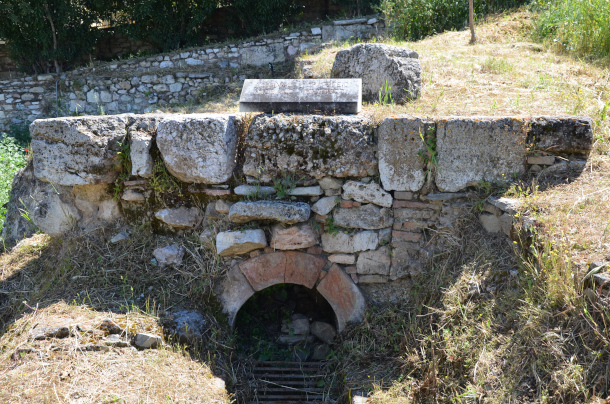
Hadrian’s aqueduct, built in the second century AD by Roman emperor Hadrian, still carries water under the city of Athens. (Photo: Carole Raddato from FRANKFURT, Germany, , Wikimedia Commons, CC BY-SA 2.0)
As the planet warms, water supplies are dwindling in Athens, Greece. To meet demand the city is looking to antiquity for solutions. One that’s attracting attention is an ancient aqueduct that runs beneath Athens. Niki Kitsantonis is a freelance journalist for the New York Times and a long-time resident of Athens, and she joins Host Jenni Doering to describe the project to fix it up and raise awareness about water scarcity.
Transcript
DOERING: Climate disruption has plagued the city of Athens, Greece with intensifying drought and extreme heat. And as the water supply dwindles and demand surges from residents and tourists alike, the city is looking to antiquity for solutions. One that’s attracting attention is an ancient aqueduct that runs beneath Athens, and it’s largely intact. So, a project to fix it up and repurpose it is underway. Niki Kitsantonis is a freelance journalist for the New York Times and a long-time resident of Athens. Welcome to Living on Earth, Niki!
KITSANTONIS: Thanks very much, Jenni.
DOERING: So tell me about this ancient aqueduct underneath Athens. Just how extensive is it, and how did it serve the city in the past?
KITSANTONIS: Well, it's an aqueduct that was built in the second century AD, it was commissioned by the Roman Emperor Hadrian, and hence its name, Hadrian's aqueduct. And it pretty much supplied Athens with water for a very long time. In fact, it only really stopped, there was a pause during Greece's Ottoman occupation when much of it was destroyed. And what isn't really widely known by the people of Athens and in Greece generally, is that it continues to operate. It's still functional. In fact, it's the longest operational underground ancient aqueduct in Europe. So it's about 15 miles, and it has lasted the test of time. I mean, it's lasted essentially 2000 years. The issue is that it hasn't been tapped into. So although the water was continuing to run, it wasn't actually being used. And that's what they're trying to change now, sort of reharnessing this ancient network to try and solve a modern problem, which is drought, or, you know, scarce water supplies.
DOERING: So what's the plan for getting this off the ground? How will the water be used, and who will get to use it?
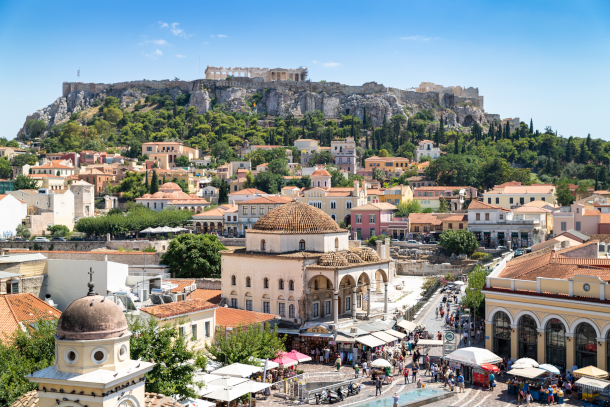
Athens is facing climate-change induced drought, heat, and wildfires. (Photo: dronepicr, Wikimedia Commons, CC BY 2.0)
KITSANTONIS: So the test project area for the aqueduct reoperating is in Halandri. Halandri is a suburb of Athens. It's actually just north of the capital, quite big for the area. It's about 80,000 people that live there. A few hundred have applied to be connected to the pipeline in the first instance. So there is, obviously, there's the ancient aqueduct, and then there's this new, smaller network that runs parallel to the ancient aqueduct and is connected by pipeline to a number of homes in this particular borough. The water is non potable, so it won't be drinking water. It'll be for use in like watering gardens, washing, that sort of thing. So the aim is then to spin it out to another seven boroughs under which the aqueduct runs. The challenge, I think that the authorities have is in raising awareness and public interest in the aqueduct, because at the moment, there isn't anything really resembling a national or even local awareness campaign. And in fact, when I was reporting it, I was talking to people literally drinking coffee in a cafe called Reservoir, the name of the cafe's Reservoir. It's right next to the central reservoir of the ancient aqueduct. And nobody knew that it existed. Most people said, Oh, I just thought that was the name of the cafe. I had no idea it was linked to an actual aqueduct.
DOERING: What is the scale here in terms of how much this aqueduct might make a dent in Athens’ water savings over, let's say, a year?
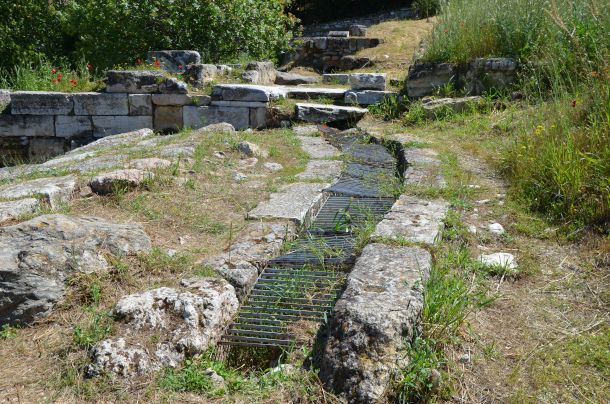
The aqueduct has survived, largely intact, for almost 2000 years. However, water hasn’t been meaningfully collected for about a century. (Photo: Carole Raddato from FRANKFURT, Germany, Wikimedia Commons, CC BY-SA 2.0)
KITSANTONIS: Well, to be honest, the actual savings in terms of water are a fraction of what Athenians use. So assuming that this network is extended to another seven boroughs, the projected saving is around 250 million gallons, which sounds like a lot, but when you bear in mind that the average annual consumption in Athens is 100 billion gallons of water, it's less than 1%. So we're talking about quite a small fraction of water that is actually going to be saved. But what the authorities are really flagging is the need to change what they call the water culture in Greece, to change the way that water is used, and to change people's habits whereby water is not just something that you can leave the shower running or the water running in the garden, as people used to do, and as lots of people I spoke to said, that that's what they used to do. And now they're telling their children, switch off the water in the garden, to cut down on their shower time, fill the bath halfway. This is something very new in Greece, because it is such a hot country, and it's becoming hotter. People were very liberal in their use of water, and this is something now that they're hoping that the reactivation of this aqueduct will help people change the way they think about water and just view it as a precious commodity, and something that needs to be preserved and not wasted.
DOERING: So it sounds like it's about more than the numbers. It's about changing culture.
KITSANTONIS: That's right.
DOERING: To what extent are there, you know, of course, this water would be going to some homes, but are there going to be any other more visible projects that, in the ways that this water is used, that Athenians will be able to see and enjoy?
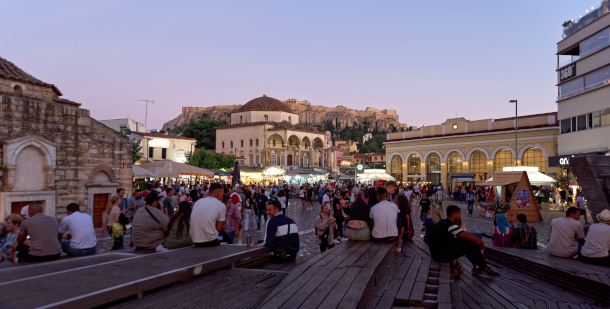
Authorities hope that by earmarking water from the aqueduct for non-potable uses, Athenians will become more aware of when and why they use water. (Photo: Jakub Hałun, Wikimedia Commons, CC BY 4.0)
KITSANTONIS: So in addition to the homes, the schools, the water from the aqueduct will be used to irrigate green areas. And the idea is to sort of reduce this heat island effect in that particular area. And the aim is to then present this as a test project to other boroughs, so that they can see what can be done with this additional water and how the impact of climate change during the summer, particularly, can be tackled with just a different approach to using water and redirecting water in a smart way to bring down temperatures.
DOERING: Yeah, as you say, that sounds really important on a really hot day in summer in Greece, to have, you know, lush green space, like a park where people can go and enjoy the benefits of those plants cooling the area.
KITSANTONIS: Right, yeah.
DOERING: So how might this model be used elsewhere? What other cities have the potential to tap into these kinds of ancient systems to address these present challenges?
KITSANTONIS: Well, one city that has asked for help from the Greek authorities is the Portuguese city of Serpa. They have a 17th century aqueduct that they plan to reharness in the same way that Athens has done with its ancient aqueduct. They're also very interested in the citizen participation aspect of the project, and the way that so many different parties managed to sort of collaborate in such an effective way. Locals in the Halandri area, the test project area, got so involved in the project. And children, school children also got involved in, not only learning about the sort of the ancient history of it, the engineering of it, but they actually got involved with some of the urban design. So they designed water tanks that are going to be in the schools. They designed green areas that are going to run over the aqueduct's course in their neighborhoods. And this is something unusual. You don't really see that much citizen participation in Greek sort of local authority projects. It's something that isn't the norm, let's say. This is also something that officials in Rome have been very interested about, which is quite ironic, because Hadrian was obviously a Roman emperor, so the Romans are now asking the Athenians for help in, not actually in reactivating an aqueduct, but in using citizen participation in other initiatives.
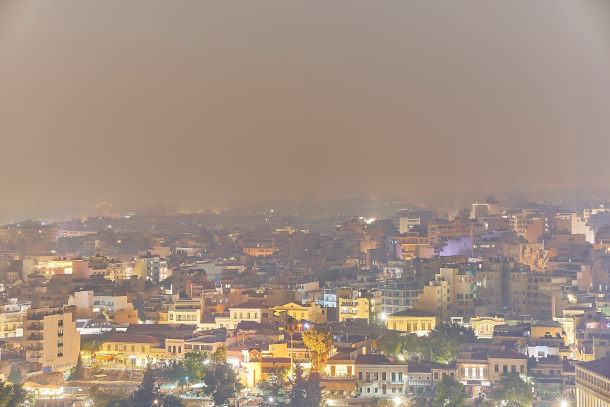
Over the last few years, wildfires have come closer to Athens. (Photo: George E. Koronaios, Wikimedia Commons, CC BY-SA 4.0)
DOERING: So Niki, from your perspective, to what extent are the climate crisis and its effects part of the public conversation in Athens and Greece more broadly, and how might this project contribute to that conversation?
KITSANTONIS: Well, the climate conversation in Greece is something relatively new and is only really something that authorities started talking about because they started seeing the intense repercussions of climate change in terms of mega fires, wildfires that spiraled out of control, heat related deaths, something very new for Greece. And in 2024 we saw three or four islands actually declaring a state of emergency because they ran out of water. So this was something that was really in the news this year, something relatively new, and something that authorities, in a way, have been obliged to start talking about. So it's becoming a part of the conversation, but only very recently. Some argue that it's a bit too late. As one would say, though, climate change is something that worldwide has been tackled, perhaps with a bit of a delay, but at least we're seeing some discussion about it now, albeit in response to quite tragic developments.
DOERING: Before you go, as a resident of Athens yourself, Niki, what are you hoping the city will look like in the coming years as we continue to adapt to climate change?
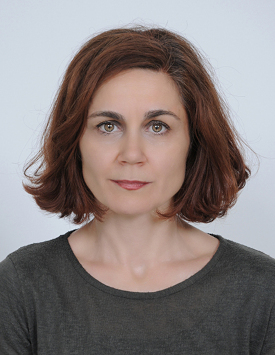
Niki Kitsantonis is a freelance journalist for the New York Times based in Athens. (Photo: New York Times)
KITSANTONIS: Well, as a resident of Athens, I do worry about what the city is going to look like in the next few years, because the truth is, over the last few years, I struggle with rising temperatures. I find that I've had to change the way I work, the way I plan my day around extremely high temperatures that were not the norm 20 years ago when I moved to Athens from London. And it's something that I worry about, because every year it gets worse and worse and more intense and it gets harder to deal with. So the thought that this could continue to intensify is quite terrifying, actually. Because apart from the practical problems of adapting to work, there's also what you see around you in terms of forest fires, which have become increasingly common and have actually become visible closer to the capital now, so it's beginning to change our life in a very visible way. And the idea behind this project is to sensitize the public to the fact that water is running out and the fact that action needs to be taken.
DOERING: Niki Kitsantonis is a freelance correspondent for The New York Times based in Athens. Thank you so much, Niki.
KITSANTONIS: Thanks, Jenni, thanks a lot.
Links
Living on Earth wants to hear from you!
Living on Earth
62 Calef Highway, Suite 212
Lee, NH 03861
Telephone: 617-287-4121
E-mail: comments@loe.org
Newsletter [Click here]
Donate to Living on Earth!
Living on Earth is an independent media program and relies entirely on contributions from listeners and institutions supporting public service. Please donate now to preserve an independent environmental voice.
NewsletterLiving on Earth offers a weekly delivery of the show's rundown to your mailbox. Sign up for our newsletter today!
 Sailors For The Sea: Be the change you want to sea.
Sailors For The Sea: Be the change you want to sea.
 The Grantham Foundation for the Protection of the Environment: Committed to protecting and improving the health of the global environment.
The Grantham Foundation for the Protection of the Environment: Committed to protecting and improving the health of the global environment.
 Contribute to Living on Earth and receive, as our gift to you, an archival print of one of Mark Seth Lender's extraordinary wildlife photographs. Follow the link to see Mark's current collection of photographs.
Contribute to Living on Earth and receive, as our gift to you, an archival print of one of Mark Seth Lender's extraordinary wildlife photographs. Follow the link to see Mark's current collection of photographs.
 Buy a signed copy of Mark Seth Lender's book Smeagull the Seagull & support Living on Earth
Buy a signed copy of Mark Seth Lender's book Smeagull the Seagull & support Living on Earth

